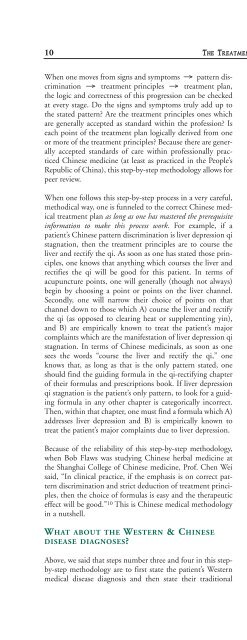The Treatment of Modern Western - Biblio.nhat-nam.ru
The Treatment of Modern Western - Biblio.nhat-nam.ru
The Treatment of Modern Western - Biblio.nhat-nam.ru
- No tags were found...
You also want an ePaper? Increase the reach of your titles
YUMPU automatically turns print PDFs into web optimized ePapers that Google loves.
10 THE TREATMENT OF MODERN WESTERN DISEASES WITH CHINESE MEDICINEWhen one moves from signs and symptoms —> pattern discrimination—> treatment principles —> treatment plan,the logic and correctness <strong>of</strong> this progression can be checkedat every stage. Do the signs and symptoms t<strong>ru</strong>ly add up tothe stated pattern? Are the treatment principles ones whichare generally accepted as standard within the pr<strong>of</strong>ession? Iseach point <strong>of</strong> the treatment plan logically derived from oneor more <strong>of</strong> the treatment principles? Because there are generallyaccepted standards <strong>of</strong> care within pr<strong>of</strong>essionally practicedChinese medicine (at least as practiced in the People’sRepublic <strong>of</strong> China), this step-by-step methodology allows forpeer review.When one follows this step-by-step process in a very careful,methodical way, one is funneled to the correct Chinese medicaltreatment plan as long as one has mastered the prerequisiteinformation to make this process work. For example, if apatient’s Chinese pattern discrimination is liver depression qistagnation, then the treatment principles are to course theliver and rectify the qi. As soon as one has stated those principles,one knows that anything which courses the liver andrectifies the qi will be good for this patient. In terms <strong>of</strong>acupuncture points, one will generally (though not always)begin by choosing a point or points on the liver channel.Secondly, one will narrow their choice <strong>of</strong> points on thatchannel down to those which A) course the liver and rectifythe qi (as opposed to clearing heat or supplementing yin),and B) are empirically known to treat the patient’s majorcomplaints which are the manifestation <strong>of</strong> liver depression qistagnation. In terms <strong>of</strong> Chinese medicinals, as soon as onesees the words “course the liver and rectify the qi,” oneknows that, as long as that is the only pattern stated, oneshould find the guiding formula in the qi-rectifying chapter<strong>of</strong> their formulas and prescriptions book. If liver depressionqi stagnation is the patient’s only pattern, to look for a guidingformula in any other chapter is categorically incorrect.<strong>The</strong>n, within that chapter, one must find a formula which A)addresses liver depression and B) is empirically known totreat the patient’s major complaints due to liver depression.Because <strong>of</strong> the reliability <strong>of</strong> this step-by-step methodology,when Bob Flaws was studying Chinese herbal medicine atthe Shanghai College <strong>of</strong> Chinese medicine, Pr<strong>of</strong>. Chen Weisaid, “In clinical practice, if the emphasis is on correct patterndiscrimination and strict deduction <strong>of</strong> treatment principles,then the choice <strong>of</strong> formulas is easy and the therapeuticeffect will be good.” 10 This is Chinese medical methodologyin a nutshell.WHAT ABOUT THE WESTERN & CHINESEDISEASE DIAGNOSES?Above, we said that steps number three and four in this stepby-stepmethodology are to first state the patient’s <strong>Western</strong>medical disease diagnosis and then state their traditionalChinese disease diagnosis. If treatment is primarily predicatedon the patient’s pattern(s), what difference does it makewhether we state these disease diagnoses or not? On the onehand, it does not make any difference. It is t<strong>ru</strong>e, no matterwhat the disease diagnosis, the bottom line in standard pr<strong>of</strong>essionallypracticed Chinese medicine is that treatment isprimarily based on the patient’s pattern discrimination. Onthe other hand, both the <strong>Western</strong> and Chinese disease diagnosesdo supply us with useful information.First <strong>of</strong> all, each <strong>Western</strong> medical disease does have its ownunique natural history. Chinese patterns are not very useful forprognosis or determining the severity <strong>of</strong> a condition. One personmay manifest yin vacuity with vacuity heat and only havea little pale red, diffuse papular acne on their forehead plus atendency to poor sleep and easy excitability, while another personwith the same pattern may have severe Cushing’s syndrome.Similarly, one person with liver depression qi stagnationmay suffer from irritability and a tendency to hiccups,while another person may be diagnosed with breast cancer. Itis the <strong>Western</strong> disease diagnosis which helps understand theseverity <strong>of</strong> the patient’s condition and alerts us to their probablecourse. Knowing that a person is suffering from hyperthyroidism,we can be on guard for thyroid storms. Knowingthat one person has fibromyalgia and another has MS, tells usthat one person’s disease is not progressive and potentially lifethreatening,while the other person’s is.Secondly, knowing a patient’s Chinese disease diagnosis canhelp us determine what their patterns are. For over 2,000years, Chinese doctors have been writing down which patternsare the main ones for each traditional Chinese disease.In Chinese internal medicine or nei ke, there is an openended,indefinite list <strong>of</strong> Chinese diseases. Because there is nosingle unifying principle grouping these together, as in gynecologyor pediatrics, they are referred to as za bing or “miscellaneousdiseases.” Some <strong>of</strong> these “diseases” are commonsymptoms, such as headache, stomachache, low back pain,tinnitus, dizziness, cough, diarrhea, and bloody nose. Othersare Chinese categories which have no exact equivalents inmodern <strong>Western</strong> medicine. <strong>The</strong> Chinese disease <strong>of</strong> mountingincludes hernias <strong>of</strong> various kinds but also covers otheringenuinal and genital region conditions which are not herniasper se, such as hydrocele, scrotal cysts, scrotal infections,testicular tumors, epididymitis, and orchitis. Wasting andthirsting covers diabetes mellitus, but it also covers thecachexia <strong>of</strong> AIDS and end-stage cancer. Strangury coversgonorrhea, cystitis, prostatitis, and even urinary tract stones.<strong>The</strong>re are hundreds, if not thousands, <strong>of</strong> Chinese books,both premodern and contemporary, which discuss the commonlyseen patterns and their treatments under each <strong>of</strong> theseChinese disease categories.<strong>The</strong>refore, if one comes across a modern <strong>Western</strong> diseasewhich one has never seen before and knows nothing about,
















